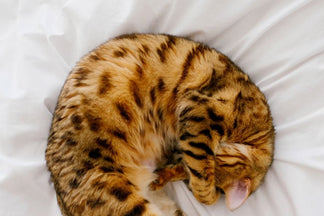October is Pet Obesity Awareness Month. By giving proper nutrition and a healthy diet, many of these diseases can be prevented. There are a variety of diseases seen in cats that are strongly related to diet. These are a few of the most common.
- Feline urologic syndrome (FUS). Also commonly known as feline lower urinary tract disease (FLUTD), diet is a major contributing factor to this disease complex. Historically, struvite (ammonium magnesium phosphate or triple phosphate) crystals and stones were more commonly found in the urinary bladder. As pet food companies and pet owners came to recognize this problem, changes were made in food ingredients that have lead to an increase in calcium oxalate crystals and stones in recent years. Calcium oxalate stones and crystals in the urinary bladder have significantly increased in incidence. We are also starting to see more of these types of stones in the kidneys and ureters as well.
- Uric acid urolithiasis. Though less common than other types of bladder stones, these stones have been linked to diet. A diet consisting of high amounts of purine such as that found in beef, poultry and fish can contribute to this disease. However, there also appears to be a breed disposition for urate crystals and stones in Egyptian Maus and possibly in Birmans and Siamese cats also.
- Taurine deficiency. Taurine deficiency is linked to dilated cardiomyopathy in cats as well as to reproductive problems in pregnant queens and their kittens. This deficiency was once common. However, commercial cat food manufacturers are now very aware of the disorder and add supplemental taurine to their foods to compensate. Home cooked diets can still pose a problem though if not balanced properly.
- Secondary nutritional hyperparathyroidism. This disorder is encountered in cats fed all meat diets. Even though cats are obligate carnivores, an all meat diet is not nutritionally balanced and complete. These diets sometimes contain too little Vitamin D and/or calcium. These deficiencies cause the parathyroid gland to deplete calcium from the bones which may in turn cause the bones to become weakened resulting in fractures, poor body condition, and other symptoms of disease. Secondary nutritional hyperparathyroidism can pose a particular problem for growing kittens.
- Obesity. Obesity is the number one nutritional disease seen in both dogs and cats. Obesity can predispose cats to a number of different disease conditions.
- Type 2 diabetes mellitus (DM). Together with leading a sedentary life style, obesity is the number one predisposing factor for developing DM in cats.
- Food allergies. Food allergies occur when there is an abnormal immune response to a protein component in the food. Food allergies typically lead to skin disease and can make your cat quite itchy and uncomfortable.
- Food intolerance. Unlike food allergies which are immunological in nature, food intolerance has a physiologic cause. Most often it results in gastrointestinal symptoms such as vomiting and diarrhea.

 Health and Fitness
Health and Fitness
 Health and Fitness
Health and Fitness
 Health and Fitness
Health and Fitness
